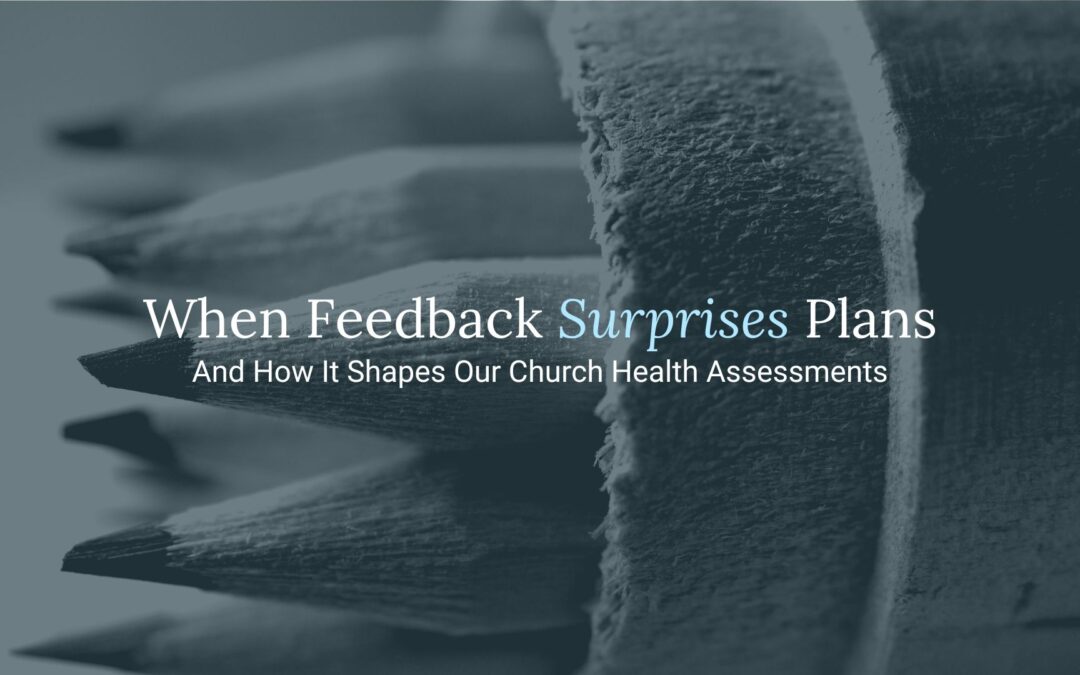
by Stephen Hay | May 23, 2025 | Spiritual Formation, Church Health, Leadership
Ministry leader, may I ask a tender but urgent question?
When was the last time you looked at the people in your congregation and thought, We are stewarding their gifts well?
If you hesitated, you’re not alone. But perhaps more importantly, if we don’t know how to answer that question, we may be missing the means God gave us to build His church.
In a time when attendance feels fragile and volunteers feel few, it’s easy to believe the lie that people aren’t interested in serving. But what if the problem isn’t a lack of willingness, but a lack of clarity?
The Church Isn’t a Stage—It’s a Body
The Apostle Paul reminds us: “Now there are varieties of gifts, but the same Spirit… to each is given the manifestation of the Spirit for the common good.” (1 Corinthians 12:4,7)
Note Paul’s words: to each is given.
There is no Christian on the sidelines of God’s mission—unless we put them there. The Holy Spirit has assigned gifts to every believer, not just for their fulfillment, but for the strengthening of the whole church. When we fail to help people identify and activate those gifts, we cut off the supply chain of the Spirit’s power meant to flow through His people.
This is not just bad leadership—it’s poor stewardship.
We Don’t Have a Volunteer Shortage—We Have a Vision Shortfall
Consider this:
85% of born-again adults have heard of spiritual gifts.
Yet nearly half, 46%, say they don’t know what their gift is, or believe they don’t have one at all.
And even among those who claim to know, only 30% can identify a biblically rooted gift. The rest either misidentify personality traits as gifts or can’t describe how their gifts are being used in the church today.
These aren’t stats to shrug at. They are a flashing warning that we’ve taught church membership without discipleship, and celebrated involvement without discernment.
Gift Awareness Fuels Spiritual Growth
Let me encourage you with this: helping people understand and deploy their spiritual gifts is not a leadership tactic—it’s a discipleship practice.
When believers are given language for how God has wired them, they begin to walk with fresh confidence in their identity in Christ. In fact, 82% of self-identifying Christians say that developing their gifts draws them closer to God. Among practicing Christians, that number rises to 97%.
Can you see the beauty? Teaching gifts don’t just get people into service—they get them deeper into Christ.
Gift Clarity Builds the Church (and Prevents Burnout)
Here’s what pastors often miss: when we fail to identify gifts, we default to filling holes. The most eager volunteers tend to receive the most tasks. Those who aren’t upfront or outspoken get overlooked. And we silently assume that “availability” is the same as “anointing.”
But what if, instead, we took time to discover who God has already placed in the room?
What if we said: No one does everything, but everyone does something. And we will help you find that something.
Churches that teach and deploy spiritual gifts experience up to a 35% greater retention of volunteers. They grow more sustainably. And more importantly, they bear fruit that lasts.
Pastor, Start With Yourself
Before you go searching your congregation for gifts, ask yourself: Do I know my own?
Your ability to lead with clarity depends on knowing how the Spirit has equipped you, not just as a shepherd, but as a part of the body. Knowing your gift mix humbles you, keeps you from over-functioning, and frees you to make space for others to lead.
Let the work begin with you. Then create a culture where others can follow.
Next Steps, Not Guilt Trips
This isn’t a call to do more—it’s a call to see differently. The Spirit has already done the heavy lifting. You’re simply called to steward the gifts He’s entrusted to your flock.
So ask the questions:
- Do we teach about spiritual gifts with biblical clarity?
- Do we help people discover and discuss their gifting?
- Do our ministries align with the gifts God has actually given?
- Do our people feel celebrated and developed, or just used?
Because if every member has been gifted for the common good, then the church has already been equipped to flourish.
We just need to unearth what’s been buried.
And then—by God’s grace—fan it into flame.

by Stephen Hay | May 23, 2025 | Church Health, Cultural Trends, Leadership
Because the gospel doesn’t segregate what Christ came to reconcile.
Ministry Leader, Let’s Talk About the People You Don’t See
You know your congregation. You could list the regulars by name. You know who makes the coffee, who sits in the back row, and which teen has started bringing their Bible or which one is always on their phone. But here’s the more searching question: do you know the family two doors down who’s never once come through your doors?
And more importantly, does your church look like them?
Scripture is clear: the gospel of Jesus is for every tribe, tongue, and nation. However, many of our churches today operate more like spiritual echo chambers than missionary outposts. Our pews remain safe, familiar, and homogenous—even when our neighborhoods don’t.
We’re not called to curate community; we’re called to embody the kingdom. And the kingdom has always been a kaleidoscope.
The Bible Doesn’t Whisper About Diversity
When Paul wrote to the Ephesians, he didn’t suggest that Jews and Gentiles might consider having a potluck together. He proclaimed something far more radical:
“He himself is our peace… who has broken down in his flesh the dividing wall of hostility.” (Eph. 2:14)
The gospel didn’t merely save individuals; it built a new people. A reconciled family. A body where every part, no matter how different, belongs to the same Head. And that means a local church that refuses to cross cultural, ethnic, or socio-economic lines is not just missing a strategic opportunity—it’s missing a theological one.
What the Data Confirms About Kingdom Diversity
This isn’t just a biblical principle—it’s backed by measurable realities. In fact:
- Racially diverse churches grow faster and sustain higher attendance over time. A 20-year Baylor study of over 20,000 Methodist congregations confirmed it.
- Multiracial congregations report stronger spiritual vitality, clearer mission, and deeper community engagement, according to the 2020 Faith Communities Today (FACT) survey.
- Yet still, 66% of American churchgoers attend a church where nearly everyone looks like them (Pew 2025).
We’re preaching reconciliation while remaining segregated by default.
What message does that send to the neighbor whose accent, skin tone, or story doesn’t match the majority in our pews? What does it say to the child being raised in a multicultural household who never sees that reality mirrored in her Sunday school room?
Diversity Isn’t a Trend—It’s a Test of Discipleship
Let’s be clear: reflecting our community isn’t a cosmetic fix. This isn’t about inclusion for appearance’s sake. This is about obedience.
When Jesus prayed in John 17, He didn’t just pray for unity among those who already had it. He prayed for a future church—a gathered people whose love for one another would authenticate His message to the watching world.
That kind of love costs something. It requires:
- Listening to the voices you haven’t heard.
- Platforming leaders who represent the diversity of your city.
- Repenting of comfort when it has become a barrier to connection.
The path to a multi-ethnic, multi-class, multi-generational church is paved with self-denial and Spirit-dependence. But it’s also paved with joy.
The Church That Mirrors Its Neighborhood Ministers to It
When your church starts to reflect your ZIP code, something beautiful happens:
- You understand the unspoken fears of your neighbors.
- You pray more specifically for their burdens.
- You learn to serve not from a distance, but from across the table.
You gain credibility, empathy, and spiritual insight—not because you’ve built a program, but because you’ve become a people.
Barna’s 2023 study found urban churches that mirrored their neighborhoods were nearly twice as likely to report deep understanding of local needs. That’s not surprising. Representation builds resonance. And resonance leads to real ministry.
Start With What You See—and Who You Don’t
Ministry leader, take a walk through your neighborhood this week. Really see it. Take a slow lap around the nearest school building. Watch who gathers in the local park. Then ask yourself honestly:
“If my church disappeared tomorrow, who would notice?”
If your answer is “only the people inside the walls,” then you don’t need a new program—you need a new posture. One of humility. Of invitation. Of alignment with the One who broke every barrier, starting with the one that separated you from God.
We Reflect Christ Best When We Don’t All Look the Same
The book of Revelation ends with a picture of perfect worship. But it doesn’t center on sameness. It centers on diverse unity—every tribe, tongue, and nation worshiping the Lamb. That’s not just a heavenly vision. That’s our present mandate.
Let’s lead churches that give our cities a preview of that glory.
Let’s build communities so blended that they can only be explained by grace.
Let’s make it normal to say, “This church looks like my community.”
And may our neighborhoods say in wonder, “We didn’t know church could look like this.”

by Stephen Hay | Apr 28, 2025 | Church Health, Conflict, Leadership
And How It Shapes Our Church Health Assessments
I had the perfect plan.
Color-coded. Carefully budgeted. The perfect five-month rollout that tied together leadership development, discipleship groups, and even a new volunteer onboarding pathway. I had charts. I had buy-in. I had the whole thing laid out like a well-prayed-over blueprint.
And then it unraveled—beautifully.
Not in a catastrophe, but in the way that only real ministry can undo you. A new believer asked a question I couldn’t answer. A seasoned leader quietly confessed he didn’t feel equipped to lead anymore. A team that looked solid on the outside was quietly struggling on the inside.
None of these realities had a column in my spreadsheet.
The Myth That “More Planning” Fixes Everything
For most of my ministry life, I operated under the quiet assumption that the better my planning, the better the outcomes. Tight timelines, clear expectations, detailed to-do lists—these were the hallmarks of “faithful stewardship” in my mind.
And don’t get me wrong: planning is a form of stewardship.
But over time, I started to see the cracks.
Because ministry isn’t a machine—it’s a garden.
And people aren’t programs—they’re living, breathing souls.
No matter how much data you gather or how well you design your strategy, people don’t always behave according to the plan. And that’s not a failure. That’s ministry.
Why Our Approach to Church Health Assessments Looks Unique
That realization changed not just my philosophy—it shaped how we now approach strategic implementation for every Church Health Assessment we offer.
When a church team partners with us, we start with a robust map:
- We gather extensive data.
- We analyze patterns.
- We identify clear pathways for growth.
The plan is real, intentional, and based on real evidence.
But—and this is critical—we plan in pencil.
Because we know:
Churches are not binary systems.
People aren’t predictable formulas.
Ministry demands flexibility because the Spirit moves in living hearts, not flowcharts.
That’s why when we walk alongside an implementation team, we don’t just drop a static action plan and walk away. We build feedback loops right into the process. Regular check-ins. Team reflections. Space for discernment. Flexibility to pivot when real life demands it.
We steward the data seriously—but we steward the people even more seriously.
How Feedback Makes the Plan Stronger
If there’s one thing we’ve learned, it’s this:
Plans give you a direction. Feedback gives you discernment.
Our strategic implementation model lives in the tension between the two.
We don’t swing to either extreme:
- We don’t throw out planning and “wing it”—that would be unfaithful.
- But we also don’t cling to a rigid plan so tightly that we miss what God is actually doing on the ground.
Instead, we move forward wisely, intentionally, but with open hands.
We ask key leaders reflective questions along the way.
We revisit strategies based on new realities.
And through it all, we remind ourselves: the goal isn’t to stick to the original map at all costs.
The goal is health. Growth. Flourishing. Gospel movement.
And those things don’t always follow our timetables.
Ministry Leaders, Here’s What I Hope You Hear
You don’t have to stop planning.
You don’t have to distrust data.
You don’t have to feel like needing to adjust means you did something wrong.
But I encourage you—whether you’re navigating a Church Health Assessment implementation or just stewarding the daily life of your church:
Plan in pencil.
Leave room for grace, for feedback, for surprising growth.
Because in ministry, faithfulness isn’t measured by how closely we stick to the original plan.
It’s measured by how closely we follow the Spirit’s leading—step by faithful step.
If your church is entering a season of strategic reflection or feeling the need for a fresh, Spirit-sensitive pathway toward health, we would be honored to walk that road with you, with a real plan, real flexibility, and a deep respect for the people God has entrusted to you.



